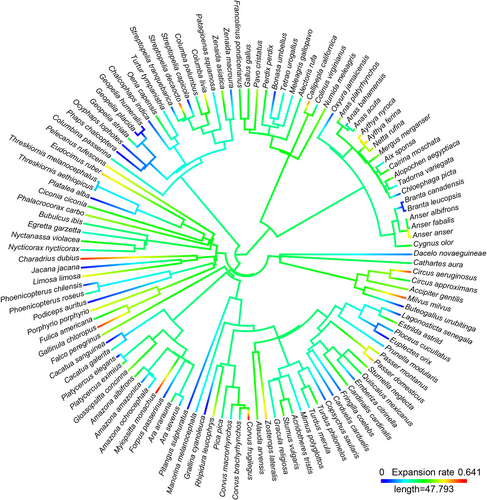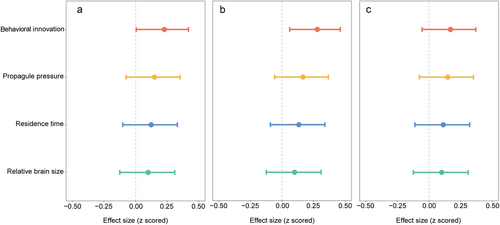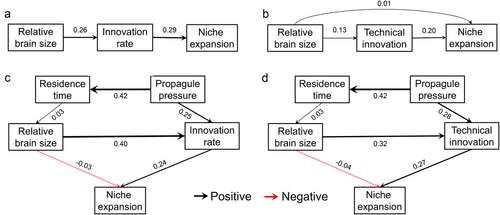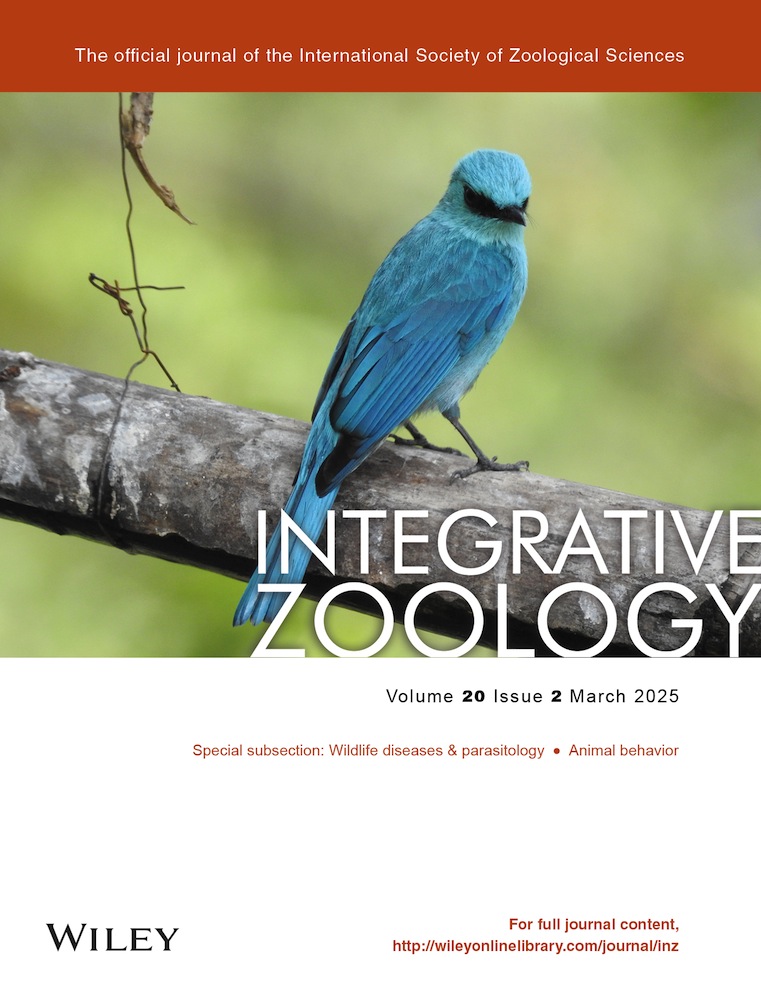Big-brained alien birds tend to occur climatic niche shifts through enhanced behavioral innovation
Abstract
Identifying climatic niche shift and its influencing factors is of great significance in predicting the risk of alien species invasions accurately. Previous studies have attempted to identify the factors related to the niche shift of alien species in their invaded ranges, including changes in introduction history, selection of exact climate predictors, and anthropogenic factors. However, the effect of species-level traits on niche shift remains largely unexplored, especially those reflecting the species' adaptation ability to new environments. Based on the occurrence data of 117 successful alien bird invaders at a global scale, their native and invaded climatic niches were compared, and the potential influencing factors were identified. Our results show the niche overlap was low, with more than 75% of the non-native birds representing climatic niche shift (i.e. >10% niche expansion). In addition, 85% of the species showed a large proportion (mean ± SD, 39% ± 21%) of niche unfilling. Relative brain size (RBS) after accounting for body size had no direct effect on niche shift, but path analysis showed that RBS had an indirect effect on niche shift by acting on behavioral innovation primarily on technical innovation rather than consumer innovation. These findings suggested the incorporation of species’ important behavioral adaptation traits may be promising to develop future prediction frameworks of biological invasion risk in response to the continued global change.
INTRODUCTION
In the Anthropocene, human activities have been facilitating the introduction of invasive and alien species (IAS) (Seebens et al. 2015), which are one major threat to global biodiversity, public health, and economies (Pyšek et al. 2020; Diagne et al. 2021; Zhang et al. 2022). Given that completely eradicating IAS after establishment is very difficult and often impossible (Simberloff et al. 2013), predicting risks of alien species invasions at the early stages is critically important to develop economical, effective prevention strategies to mitigate IAS effects (Fournier et al. 2019).
Ecological niche models (ENMs) based on species’ realized niches have been widely used for the prediction of the risk of invasion by alien species (Guisan et al. 2013). Generally focusing on climate as one most frequently used ecological niche of species, and a key assumption for the application of ENMs is that species realized climatic niches tend not to change after alien species invaded new ranges (also known as the niche conservatism hypothesis, Peterson et al. 1999; Wiens et al. 2010), which has been observed across taxa (Petitpierre et al. 2012; Strubbe et al. 2015; Beukema et al. 2018). However, increasing examples of climatic niche shifts are observed across plants (Atwater et al. 2018), birds (Cardador & Blackburn 2020), herpetofauna (Li et al. 2014; Tingley et al. 2014; Liu et al. 2017), fishes (Lauzeral et al. 2011; Parravicini et al. 2015), and insects (Hill et al. 2017), which are challenging the fundamental theory of ENMs, warranting further investigations on factors influencing IAS niche shift to developing risk prediction of alien species invasions.
Since the debate on climatic niche conservatism, great efforts have been made to identify the factors that influence climatic niche shifts from the aspects of introduction history such as residence time and changes in biotic interaction (Li et al. 2014; Strubbe et al. 2015), selection of exact climatic niches (Liu et al. 2017), and anthropogenetic factors influencing invasion process (Cardador & Blackburn 2020). For instance, previous studies have shown that established alien herptiles tend to occur climatic niche shifts when they have relatively small native range sizes or when they are introduced earlier (Li et al. 2014). Further studies have indicated that the climatic niche of alien herpetofauna tends to be conserved along maximum temperatures (Liu et al. 2017). In addition, close associations were noted between human activities and the climatic niche dynamics of established alien birds (Cardador & Blackburn 2020). However, few studies explored the role of species-level traits in IAS climatic niche dynamics although they have been widely hypothesized as important predictors of alien species invasion success (Capellini et al. 2015; Allen et al. 2017).
Among species traits, parameters such as brain size and/or behavioral innovation reflecting the species ability that can rapidly adapt to novel environments have been suggested as important to alien species invasion success (Sol & Lefebvre 2000; Sol et al. 2012; Wang & Liu 2021). For instance, when an alien species is introduced into a novel environment, it needs to learn to use novel resources, avoid novel predators, and change behavior to adapt to the change of local environmental and biological selection pressures (Sol et al. 2005). For example, previous studies suggested that relatively large brains might have an advantage in adapting to novel or changing environments (Potts 1998; Fong et al. 2019), and thus successful invaders tend to with larger brains (Sol et al. 2008). Nevertheless, a closely positive correlation exists between brain size and more direct factors such as behavioral innovation reflecting species’ learning ability in mammals (Reader & Laland 2002; Navarrete et al. 2016) and birds (Lefebvre & Nicolakakis 2000; Sayol et al. 2016). For example, species often adapt to changing climates or modified resources through behavioral plasticity (Varner & Dearing 2014), which allows species to tolerate rapid environmental changes (Sih et al. 2012; Baldwin et al. 2022). Behavioral innovation is a common variable reflecting species' behavioral plasticity (Tuomainen & Candolin 2011) and is considered crucial for species' adaptation to new environments and thus the potential to occupy new climatic niches (Varner & Dearing 2014). Additionally, evidence has shown that birds with larger brains adapt to new environments through higher cognitive abilities such as behavioral innovation, independent of non-cognitive abilities (Sol et al. 2005). Thus, distinguishing the relative importance of brain size and other innovation behavior predictors and examining their direct and indirect roles in explaining alien animal invasion are important (Sol et al. 2005). Based on previous studies, we hypothesize that alien species with larger brains owing to enhanced behavioral innovation might have a higher probability of experiencing climatic niche shifts than species with smaller brains and less behavioral innovation abilities in a new environment. Although rational in theory, few empirical studies have been conducted to link alien species' brain size, behavioral innovation, and other confounding factors with IAS niche shifts.
Here, a global database including 117 successful alien bird invaders with available brain size and behavioral innovation data was used to explore their relationships with realized climatic niche shifts after accounting for propagule pressure and residence time that may influence niche shift of alien birds (Strubbe & Matthysen 2014; Cardador & Blackburn 2020). We predict that alien birds with larger brains and higher behavioral innovation are more likely to experience climate niche shifts in invaded ranges. Realized climatic niche shift was defined as >10% niche expansion (Petitpierre et al. 2012). Phylogenetic generalized least squares (PGLS) models were used to test the relative importance of relative brain size (RBS), behavioral innovation, and other covariates in predicting the observed climatic niche shift after controlling phylogenetic non-independence of species traits and ecological niche characteristics among IAS. We also conducted path analysis to explore the possible causal relationships and disentangle the direct and indirect effects of brain size and behavioral innovation on the observed climatic niche shift.
MATERIALS AND METHODS
Species occurrence data
According to the Global Avian Invasions Atlas database, alien bird species that have successfully established populations in non-native ranges are used in our study (Dyer et al. 2017). Then, a total of 117 species were matched with brain size and behavioral innovation variables for subsequent analysis. Species occurrence data were compiled from the Global Biodiversity Information Facility (GBIF, https://www.gbif.org/; Table S1, Supporting Information), Integrated Digitized Biocollections (IDIGBIO, https://www.idigbio.org/), Biodiversity Information Serving Our Nation (BISON, https://bison.usgs.gov/), and iNaturalist (INAT, https://www.inaturalist.org/). To correct for sampling biases, 5 arcmin (10 km × 10 km) spatial thinning was performed using the spThin package in R (Aiello-Lammens et al. 2015; R Development Core Team 2022; Han et al. 2023). According to the BirdLife International and NatureServe (http://datazone.birdlife.org/species/requestdis) defining the natural ranges of the alien birds, the distribution data were divided into native and invaded ranges. Only species with >50 locations in native ranges and >5 locations in invaded ranges were considered valid data (Broennimann et al. 2012; Cardador & Blackburn 2020). After data cleaning, final distribution data averaged 1556 ± 3706 (mean ± SD) locations in native ranges (range: 60–26 513) and 1518 ± 2031 (range: 56–13 425) in invaded ranges for 117 species.
Bioclimatic variables
From the CHELSA database (https://chelsa-climate.org/), we obtained a total of 19 bioclimatic variables (Karger et al. 2017). We selected six bioclimatic variables with relatively low multicollinearity (Spearman correlation coefficient, r < 0.9; Cardador & Blackburn 2019; Fig. S1 and Table S2, Supporting Information), including temperature (temperature seasonality, maximum temperature of warmest month, and minimum temperature of coldest month) and precipitation (precipitation seasonality, precipitation of wettest month, and precipitation of the driest month) variables that are known to affect bird distributions (Barbet-Massin & Jetz 2015; Liu et al. 2020b).
Geographical background
The geographical background was defined as the area that includes native and invaded ranges, plus the space in which a species may not be able to colonize due to geographical barriers and species interactions (Barve et al. 2011; Soberón & Peterson 2011; Hill et al. 2017). The range of climate available to the species is contained within these backgrounds. The geographical background was used in the process of quantifying niche change and has important effects on the results (Hill et al. 2017). A larger geographical background enables optimal coverage of suitable environmental conditions to investigate niche conservatism at the global scale, thereby improving the accuracy of the results (Mateo et al. 2015). We, therefore, used the zoogeographic regions (Afrotropical, Australian, Madagascan, Nearctic, Neotropical, Oceania, Oriental, Palearctic, Panamanian, Saharo-Arabian, and Sino-Japanese; Holt et al. 2013) that have been used for the definition of native and invasive ranges in literature. If a species has a distribution in two or more native regions, its native zoogeographic region is defined based on the midpoint location of the ranges (Li et al. 2014).
Climatic niches
The dynamics of realized climatic niches by all species was quantified using a robust framework (Broennimann et al. 2012). The first two axes of a principal components analysis (PCA) were projected using species data. A total of six climatic variables (Table S2, Supporting Information) are included in PCA. The first (50.55%) and second (26.41%) axes explained 76.96% of the total climate variation, so we did not consider more axes. PCA was calibrated using all climatic conditions in the native and invaded extent. Kernel smoother was used to estimate the density of species occurrence and rescaled them to a resolution of 1000 ×1000 grid cells. Niche overlap was calculated with Schoener's D (Warren et al. 2008). Three parts of niche change (niche expansion, stability, and unfilling) were quantified using the ecospat package (Petitpierre et al. 2012; Di Cola et al. 2017). Niche expansion refers to the environmental space occupied only in the invaded ranges. Niche stability refers to the environmental space occupied in both native and invaded ranges. Niche unfilling refers to the environmental space occupied only in the native ranges.
Factors influencing niche change
Data on brain size and body size for 117 species were compiled from a variety of literature (Garnett et al. 2015; Fristoe et al. 2017; Sayol et al. 2018; Ksepka et al. 2020). RBS was estimated as the residual of the log–log PGLS regression of absolute brain size to body size (Sayol et al. 2020). Behavioral innovation (foraging innovation) data were extracted from Ducatez et al. (2020). Behavioral innovation was divided into technical innovations, consumer innovations, and innovation rates following Ducatez et al. (2020). Technical innovation was defined as a novel act of searching for and handling food. Consumer innovation was defined as the addition of a new food to the diet of a species (Overington et al. 2009). Innovation rate was defined as the sum of technical innovations and consumer innovations (Ducatez et al. 2020). Research efforts (number of papers published for the species) were derived from the online version of Zoological Record (Ducatez & Lefebvre 2014). Research efforts were correlated with behavioral innovation, so we removed this effect by calculating the residuals from the log–log regressions of behavioral innovation against research effort. We ran the analyses again, and most of the models produced consistent results. Residence time refers to the number of years that have elapsed since the first successful introduction of a species, which was obtained from the Global Avian Invasions Atlas (Dyer et al. 2017). Propagule pressure refers to the number of non-native ranges in which a species has been introduced, including propagule number (the number of introduction events) and propagule size (the number of individuals introduced in each event), which were obtained from Redding et al. (2019).
Statistical analyses
Log 10-transformed data for different variables were collected to meet the normality assumption. The avian tree containing the sampled species obtained from www.bridtree.org (Jetz et al. 2012) was used to account for phylogenetic uncertainty. To represent model residual phylogenetic structure, PGLS models (Freckleton et al. 2002) using the caper package (Orme et al. 2012) were employed. The phylogenetic scaling parameter λ (λ = 0 indicating phylogenetic independence and λ = 1 indicating complete phylogenetic dependence) using a maximum-likelihood method in each model was estimated (Freckleton et al. 2002; Jiang et al. 2022). The superscripts following the λ value represent the P-value of these tests (Jiang et al. 2023). PGLS models were applied to test the relative importance of brain size, behavioral innovation (i.e. innovation rate, technical innovations, and consumer innovations), and other covariates (i.e. residence time and propagule pressure) in predicting the observed niche shift. Mixed-effects models were then run to calculate the standardized effect size for each of the predictor variables. Finally, phylogenetic confirmatory path analyses were performed to disentangle the associations of the niche shift with RBS, behavioral innovation, residence time, and propagule pressure (von Hardenberg & Gonzalez-Voyer 2013). Using the R package phylopath, all candidate models were ranked according to their C-statistic Information Criterion (CICc), and those models with CICc < 2 were used as the top models to examine the conditional independences of each model in a PGLS method (von Hardenberg & Gonzalez-Voyer 2013; van der Bijl 2018; Jiang et al. 2023).
RESULTS
Dynamics of alien bird realized climatic niches
Our analyses show a low climatic niche overlap between native and invaded ranges across alien bird species (Schoener's D: mean ± SD, 0.26 ± 0.14, n = 117). In addition, climatic niche shift (i.e. >10% climatic niche expansion) was commonly detected across 88 alien birds (mean ± SD, 27% ± 17%; Fig. 1; Fig. S2, Supporting Information). A total of 100 alien birds showed >10% climatic niche unfilling (mean ± SD, 39% ± 21%).

Factors influencing realized climatic niche shifts
The niche expansion of alien birds was positively correlated with overall innovation rate (t113 = 2.033, P = 0.045, λ = 0.1631.000,<0.001; Figs 2, 3) and technical innovations (t113 = 2.531, P = 0.013, λ = 0.1591.000,<0.001; Figs 2, 3) but was not significantly associated with consumer innovations, relative brain size, residence time, or propagule pressure (Table 1). Niche overlap or niche unfilling was not related to other variables (Tables S3,S4, Supporting Information).


| Predictor | λ | t | R2 | P |
|---|---|---|---|---|
| Relative brain size | 0.1751.000,<0.001 | 0.869 | 0.010 | 0.387 |
| Residence time | 1.509 | 0.029 | 0.217 | |
| Propagule pressure | 1.244 | 0.020 | 0.135 | |
| Innovation rate | 0.1631.000,<0.001 | 2.033 | 0.222 | 0.045 |
| Residence time | 1.079 | 0.015 | 0.283 | |
| Propagule pressure | 1.318 | 0.022 | 0.191 | |
| Technical innovations | 0.1591.000,<0.001 | 2.531 | 0.827 | 0.013 |
| Residence time | 1.168 | 0.018 | 0.246 | |
| Propagule pressure | 1.464 | 0.027 | 0.147 | |
| Consumer innovations | 0.1621.000,<0.001 | 1.493 | 0.028 | 0.139 |
| Residence time | 0.982 | 0.012 | 0.328 | |
| Propagule pressure | 1.294 | 0.021 | 0.199 |
- Bold number indicate significant result.
To control for the potential effect of the collinearity among predictor variables (e.g. RBS was positively correlated with innovation rate: t = 3.683, df = 115, P < 0.001, with technical innovations: t = 2.460, df = 115, P = 0.015, and with consumer innovations: t = 3.693, df = 115, P < 0.001; Fig. S3, Supporting Information), a phylogenetic confirmatory path analysis was further performed based on different hypothesized candidate path models (Figs S4–S7, Supporting Information). A total of three or eight candidate models were ranked according to their CICc, with ΔCICc ≤ 2 as the best model. Four path analysis graphs with different combinations of innovation rate (Fig. 4a,c) and technical innovations (Fig. 4b,d) were constructed. Niche expansion increased with innovation rate and brain size. However, the direct relationship between niche expansion and brain size was not significant, but innovation rate especially for technical innovations was an important predictor of niche shift according to the path analysis. Further model averaging analyses showed that RBS acted on niche expansion indirectly through behavioral innovation (Fig. 4; Fig. S8 and Tables S5–S8, Supporting Information).

DISCUSSION
Our present study observed a large proportion of climatic niche shifts among alien birds, which supports previous studies across taxa (Guisan et al. 2014; Hill et al. 2017). One explanation was that the distribution range of alien birds is not so obviously limited by climate (Beale et al. 2008) but is also highly related to human influence and urbanization (Cardador & Blackburn 2020), which finds that niche expansion in alien birds is manifested mainly in species associated with more human disturbances. More than 85% of the alien birds show niche unfilling, which is consistent with previous studies that also observed a high proportion of alien birds (Strubbe et al. 2013; Strubbe et al. 2015). Given that most bird introductions are relatively recent events (Dyer et al. 2017), our results suggest that alien birds may have only occupied a part of suitable climates in their invaded ranges and have the potential to further expand more suitable ranges. Our paper further proves that no significant relationship exists between niche expansion and propagule pressure or residence time (Strubbe et al. 2015).
A direct relationship is not found between niche expansion and the RBS of alien birds that has been shown to enhance establishment success in their invaded ranges (Sol et al. 2008, 2012). However, phylogenetically controlled path analysis detected an indirect effect of relative brain size on niche shift by acting on behavioral innovation. Relative brain size is closely related to brain structure and function; accompanying changes in brain structure and function may generate new ecologies or behaviors that allow populations to colonize new geographic areas or habitats (Eliason et al. 2021). Previous studies demonstrated that larger relative brain size can enhance behavioral plasticity to changing environments (Sayol et al. 2019). Birds with larger brains can have higher cognitive abilities and thus higher behavior innovativeness (Overington et al. 2009). Alien birds face a range of new challenges in novel environments with unfamiliar prey and predators, which are needed to overcome by more flexible behaviors (Schlaepfer et al. 2005; Watters & Meehan 2007). Larger brains can help species better resist these challenges by aiding the individual's propensity to modify or invent new behaviors (Lefebvre et al. 1998; Seyfarth & Cheney 2002).
Previous studies have demonstrated that larger relative brain sizes promote niche shifts and range expansions by enhancing behavioral plasticity (Ducatez et al. 2015; Sayol et al. 2019). Consistent with previous studies, our results show that relative brain size has a positive correlation with behavioral innovation (Timmermans et al. 2000; Sayol et al. 2016), which is a more direct variable that reflects the ability of a species to adapt to novel environments (Sol et al. 2005; Wang & Liu 2021). For example, we found that Corvus frugilegus (Passeriformes) experienced significant niche shifts (63.46%) in the invasion area. This species was a successful disperser with a larger brain, greater cognitive abilities, and behavioral innovation (Jønsson et al. 2012). This finding supports our initial prediction that alien species with larger brains owing to enhanced behavioral innovation might experience higher climatic niche shifts than species with smaller brains in new environments. Our results indicate that behavioral innovation represents the cognition, learning, and rapid adaptation ability of alien birds to cope with novel environments, thus improving their invasion success rate (Wang & Liu 2021), which supports the fact that plasticity behaviors, especially foraging behaviors, are critical for species to tolerate changing climate and resource availability. Foraging innovations help alien species survive in changing climates (temperature and precipitation) and occupy new climatic niches (Varner & Dearing 2014).
Furthermore, the importance of foraging innovations in predicting climatic niche shifts of alien birds is mainly dependent on technical innovation but not consumer innovation. One potential explanation is that the species’ ability to find hard-to-reach foods might be more important for alien birds to occupy new niches. This result supports a previous study that consumer innovation has a smaller effect size than technical innovation in explaining alien bird establishment success (Wang & Liu 2021). Technical innovations are related to the cognitive abilities of animals associated with finding new resources (Overington et al. 2009). Our analysis reinforces the findings of other studies reporting that birds with larger brains adapt to new environments through higher cognitive abilities, rather than non-cognitive abilities (Sol et al. 2005).
The prevalent climatic niche shifts of alien birds observed in the present study demonstrate that the climate-matching assumption cannot be used simply for invasion risk assessment of alien birds. More non-climatic parameters at the species level such as biotic interactions to predict alien species invasion risks at early stages need to be considered (Liu et al. 2020a; Carlin et al. 2023; Han et al. 2023). Our present study implies that the incorporation of species' important traits reflecting their ability to adapt to novel environments such as behavioral innovation may be promising for developing future prediction frameworks of biological invasion risks.
CONCLUSION
Assessing the strength of climatic niche shift and its drivers is key to predicting the risk of alien species invasions. Up to 88 of the 117 bird species show evidence of climatic niche shift. Our results show that behavioral innovation is a more important variable than most of the other event- or location-level variables, such as residence time and propagule pressure, in predicting the climatic niche shift of alien species in a new environment. Furthermore, we find that behavior innovation is indeed important to predict niche shifts, especially for technique innovation compared with consumer innovation. Our findings contribute to understanding the impact of behavioral innovation on the climate niche shift of alien species and may help improve our ability to accurately assess invasion risk.
ACKNOWLEDGMENTS
Financial support was provided by the National Natural Sciences Foundation of China (32200338, 32171657, 31970393, and 31870507), the Third Xinjiang Scientific Expedition Program (2022xjkk0800, 2021xjkk0600, and 2021xjkk1203), the grants of high quality economic and social development in southern Xinjiang (NFS2101), the grants from Youth Innovation Promotion Association of Chinese Academy of Sciences (Y201920), the Key Project of Natural Sciences Foundation of Sichuan Province (22NSFSC0011), and the Census on forest and grass germplasm Resources and invasive alien species in Tianjin Municipality (SHGP-2022-B201).




